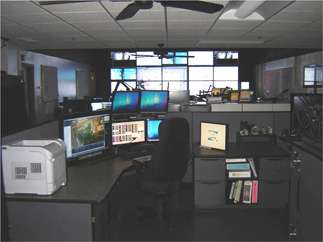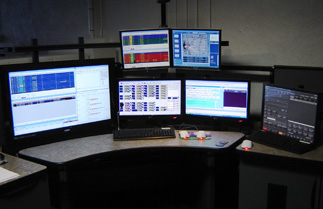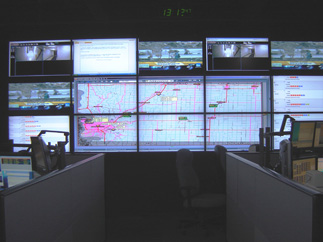Pottawattamie County Sheriff's Office
1400 Big Lake Road
Council Bluffs, Iowa 51501
Office: 712-890-2200
Non-Emergency : 712-328-5737
Emergency: 911
Communications Center
POTTAWATTAMIE COUNTY COMMUNICATIONS CENTER MISSION STATEMENT
The Pottawattamie County Communications Center, a division within the Office of the Sheriff, will operate under the procedures and the mission statement of that office. Pottawattamie County Communications Public Safety Professionals are committed to serving with integrity, compassion and care for the welfare and safety of our citizens, personnel and those traveling through Pottawattamie County. All requests for assistance, whether received via the 9-1-1 telephone system or the emergency radio system, will be fulfilled in a professional and timely manner.
| Location | Telephone Numbers | Office Hours |
|---|---|---|
| Pottawattamie County Court House 227 South 6th Street Council Bluffs, Iowa 51501 |
Office: 712-328-5654 Non-Emergency: 712-328-5737 Emergency: 911 |
24 Hours A Day/7 Days a Week |
Overview
In July 2007 the Pottawattamie County Sheriff's Office took over the management of the Communications Center which had formerly been governed by a group of appointed and elected officials. The Pottawattamie County Sheriff's Office Division of Communications consists of 30 dedicated personnel providing a support role for operational public safety agencies within Pottawattamie County, Iowa. The Sheriff's Communications Division plays a critical role in delivery of all Law, Fire and Medical calls within the county. Additionally, the Communications Division is responsible for the maintenance on the county's state of the art digital trunked radio system and communications infrastructure used by all Law Fire and EMS.
Pottawattamie Sheriff's Office Division of Communications is the Public Safety Answering Point (PSAP) receiving and dispatching emergency and nonemergency calls for service for all of Pottawattamie County including the following cities/townships:
- Avoca
- Carson
- Carter Lake
- Council Bluffs
- Crescent
- Hancock
- Lewis Township
- Macedonia
- McClelland
- Minden
- Neola
- Oakland
- Shelby
- Treynor
- Underwood
- Walnut
Pottawattamie County Sheriff's Office Division of Communications provides 24 hours a day, 7 days a week combined public safety communications services for:
- Pottawattamie County Sheriff's Office
- Council Bluffs Police Department
- Council Bluffs Fire Department
- Carter Lake Police Department
- Avoca Police Department
- 14 Professional Volunteer Fire and Rescue Departments
- Numerous City and County Support Services
- 90,000 plus citizens covering 960 square miles
Information and Tips for Calling 9-1-1
- 9-1-1 should be called for emergencies, such as crimes in progress, to report a fire or for a medical emergency.
- For non-emergencies, such as parking problems, non-injury car accidents, thefts or vandalism (when the suspect is gone) call 712-328-5737
- Remember to remain calm, speak clearly and follow any instructions the dispatcher gives you.
- Be prepared to provide the location of the emergency. Always know your location and be ready to give directions to the dispatcher. Descriptive information such as cross streets, mile markers, landmarks, and business names are helpful.
- The dispatcher will verify your address and phone number. (Even if they have this information on their screen already.)
- Do not hang up until the dispatcher tells you to. Even if you dialed by mistake, stay on the line and explain that you accidently dialed.
- The dispatcher will ask you questions. Stay calm and answer the questions clearly. This questioning does not delay the response of Law Enforcement/Fire/EMS Personnel. It does provide the responders with more information as they are enroute so they can be better prepared when they arrive.
- When describing a person start at the top of the head and work your way down. The dispatcher may ask the person's race, sex, age, height, weight, hair color, clothing description, and any other distinguishing characteristics.
- When describing a vehicle the dispatcher may ask the color, year, make and model, body style, license plate and state, and any other distinguishing characteristics.
Enhanced 9-1-1/Frequently Asked Questions
Enhanced 911:
Landline: When you place a 9-1-1 call from a landline (wired) phone, the call is routed to the telephone company's central office and then to the 9-1-1 Center. As the call is placed, a data dip is sent to a central database located in Denver, CO. As the call is answered in our 9-1-1 Center, the information received from Denver populates on our screens providing us with the location, phone number and name of the subscriber.
Wireless: There are two types of Enhanced 9-1-1 for wireless (cellular) phones. Phase 1 requires the cellular phone company to provide the call back phone number and cellular tower location to the 9-1-1 Center. Phase 2 requires the cellular phone company to provide the call back phone number and the latitude and longitude location of the cellular phone accurate to within 300 yards.
VoIP (Voice over Internet Protocol): This phone service connects using the internet. With VoIP phones, 9-1-1 service requires activation and you must register the physical location of the phone line with your service provider and update the information when you move. Then the service provider will be able to provide the information to the 9-1-1 Center when you call. Also with VoIP phones, you cannot dial 9-1-1 in the event of an internet or power outage.
FAQ's:
Can I Call 9-1-1 if I use a T.D.D.?:
Yes, your 911 Center is equipped with TDD/TTY equipment. Communications professionals receive extensive training in handling emergency situations utilizing this special equipment.
Can someone call 9-1-1 who does not speak English?:
Yes, your 911 Center subscribes to a telephone translation service providing access to interpreters who speak more than 140 languages and are available 24 hours a day, 7 days a week, for emergency communications services with non-English speaking callers.
I called 9-1-1 and now my cell phone is in emergency mode?:
This is a feature provided by your phone company and has nothing to do with the 9-1-1 center. If you cannot get out of emergency mode try turning your phone off and back on or taking the battery out. If this still does not work, call your cell phone company.

Contact Us
| Captain of Communications | Sam Arkfeld | 712-328-4866 |
|---|---|---|
| Communications Coordinator | Angela Dobyns | 712-435-5246 |
Links
- Council Bluffs Police Dept
- Carter Lake Police Dept
- Council Bluffs Fire Dept
- Pottawattamie County Emergency Management
- Other Pottawattamie County Offices
- NENA (National Emergency Number Association)
- APCO (Association of Public-Safety Communications Officials)
- VoIP (Voice over Internet Protocol)
- 9-1-1 for Kids




